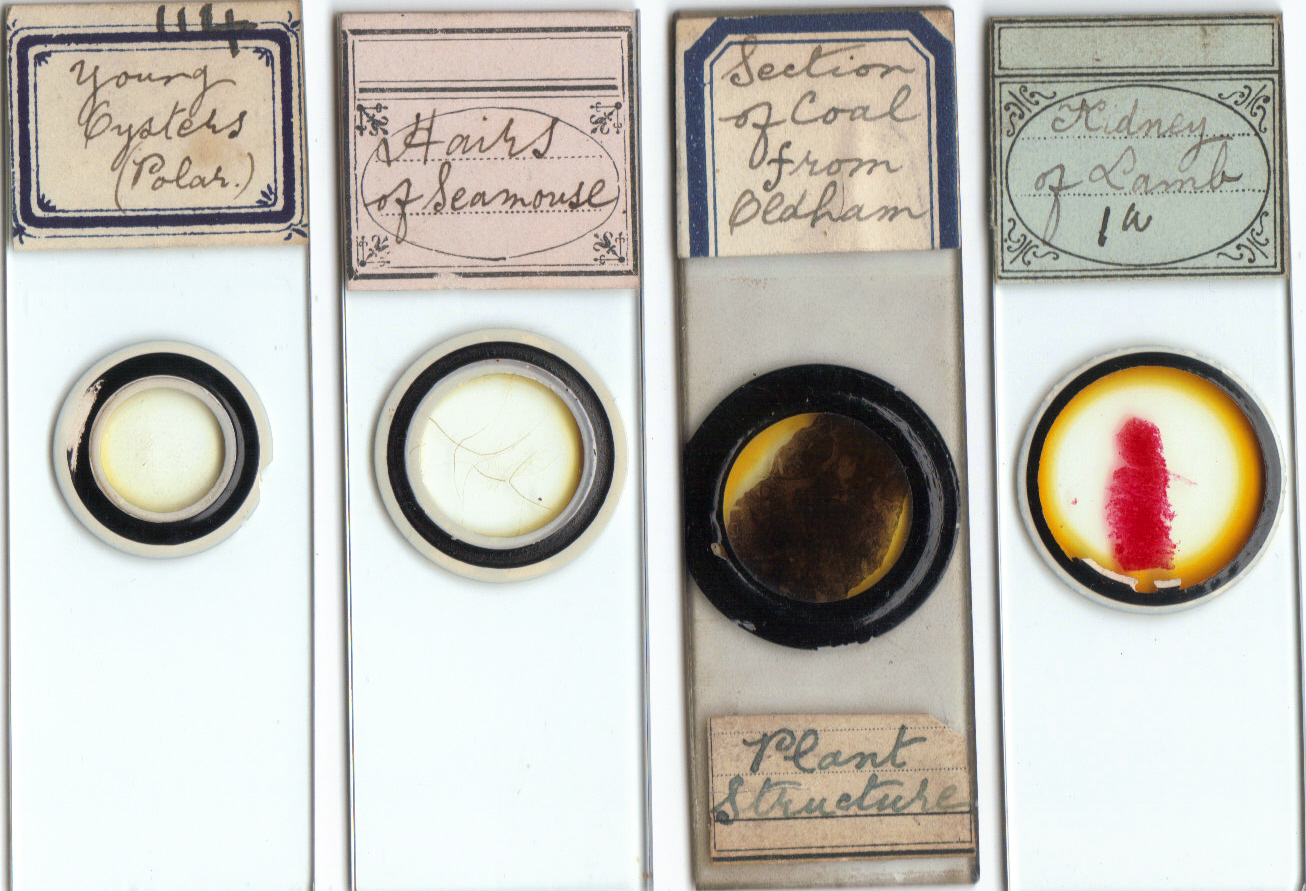
THOSE OTHER SUTER SLIDES
Peter B Paisley
Sydney, Australia
Frustratingly often, handwriting on slides is very difficult to identify, due to similarities amongst writers. Cottam, for example, rarely signed or initialled his slides, and several other diatom mounters have such similar styles that without Cottam’s monogram label, identification (in the eye of the beholder) may merely betray wishful thinking.
Yet sometimes one encounters mounters whose identification is beyond doubt, and one such is Richard Suter. Aberrant Suter labels with several patterns occur quite often in collections. While original collectors presumably knew well who prepared them, the passage of time and dispersal of old cabinets’ contents has left those other Suter slides unrecognised.

Some of those other Suter slides. The coal section is mounted on glass frosted on the front side.

More other Suter slides
Suter had several styles: the most commonly found being square labels, with an address at 5, or 10, Highweek Road, Tottenham, but there were others, as illustrated here. He probably tried various designs before settling on his most familiar label, mostly using that thereafter.

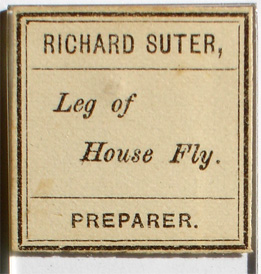
Various colours, shades and formats tried by Suter. The foraminifera slide is on white glass.
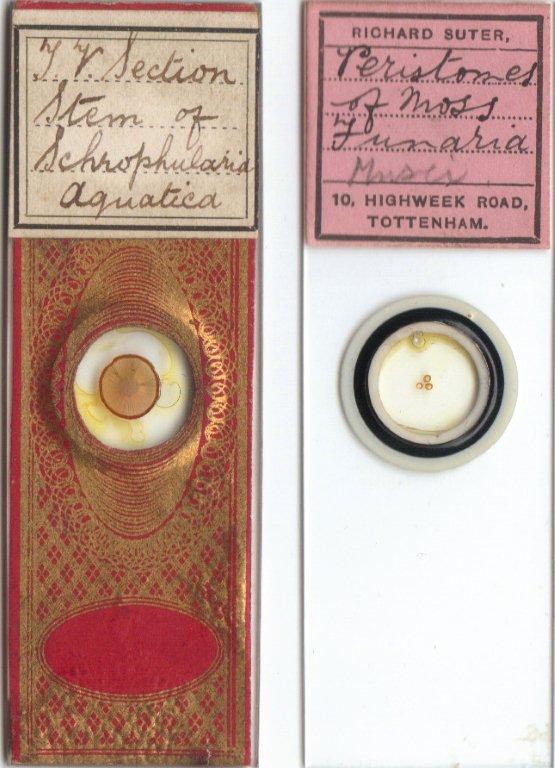
Two ends of the Suter label spectrum: left, a rare early slide, papered on one side; right, an example familiar to most collectors, which became his benchmark colour and pattern.
Suter’s large output yields exact comparisons of written letters, or whole words, between printed labels and these other examples. Comparisons below should satisfy any fastidious forensic gaze.
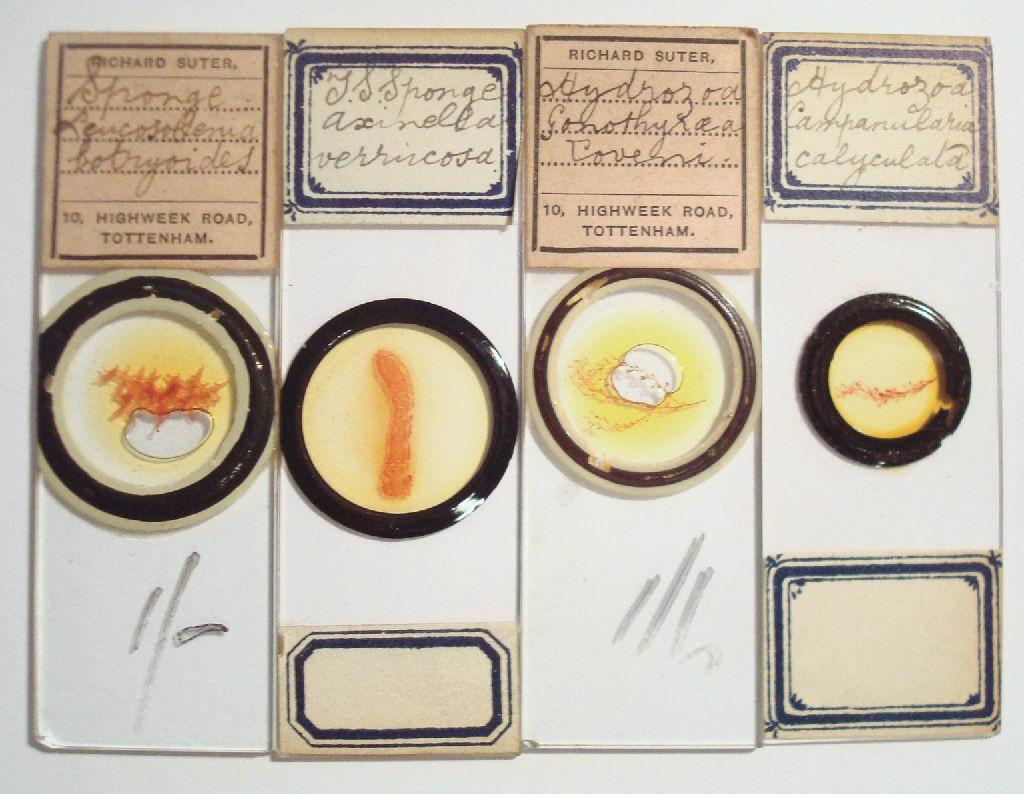
Printed named labels provided de facto advertising, but none of Suter’s “other” labels carry even a set of initials. In Highweek Rd., Tottenham, he lacked no opportunity to obtain labels. He was surrounded by requisite trades within minutes’ (sometimes seconds’) walking distance – a lithographer at no.12 (next door, after the Suters moved from no.5 to no.10), a printers’ compositor at no.16, a photographic printer at no.24, a lithographer/engraver at no.30, a lithographer at no.35, and a stationer at no.40. When the Suters left no.5, a compositor moved in.
There was possibly a commercial relationship between the lithographer Isaac Joseph at no.12 (later at no.24), and Richard Suter senior. Isaac Joseph in 1871 was a printer/lithographer in Finsbury, and his sister Mary was a bookfolder: Richard Suter senior was not far off in Shoreditch, bookbinding. In 1881 both families were still in inner London, with Isaac Joseph then described as a wholesale stationer’s clerk. By 1891 both families were in the same Tottenham street, and by 1901 Isaac Joseph (since the move, again a lithographer) had a bookbinder daughter. The families may have moved to Tottenham (some time in the mid 1880s) in a joint business venture, or formed one soon in Tottenham. Suter’s father and grandfather being bookbinders, printing contacts extended beyond Highweek Rd., if necessary – but one existed next door. It is rare to discover a designer/ lithographer for a preparer’s labels, but it seems highly probable that for Suter, this was his neighbour Isaac Joseph. So: why were some Suter labels apparently slapdash?
Firstly, Suter offered slides on approval, paralleling the philatelic example which began well before 1900. (Suter’s advertisements sought stamps, among other things). He may have been less precise with approval labels. Why use his best labels if slides were to be returned?

Science Gossip, December 1889: one of many entries seeking stamps, in the exchange columns
And if recipients kept their slides, approval labels would remain. Successful approvals accumulating for a given specimen might prompt mass production, now with printed labels, for inclusion in his next catalogue.
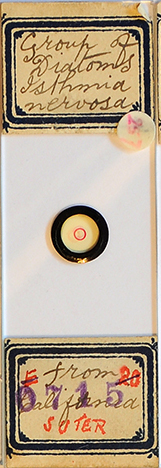
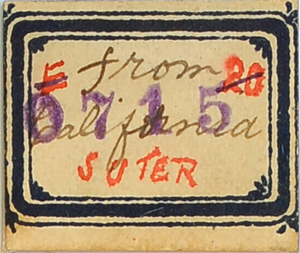
Possibly one of Suter’s approvals, with annotation in red ink by the recipient
Secondly, an output as large as Suter’s over a long period may have involved his printer(s) running out of supplies from time to time. If Suter was forgetful in ordering labels far enough in advance, he may have used whatever came to hand while awaiting replenishments.
Thirdly: Suter was a schoolteacher, and since the microscope and its revelations were embedded in Victorian English education – commonly to illustrate God’s ingenuity – he may have supplied his “other” slides to pupils, either free or at reduced cost. Suter was in serious slide production some years before he quit school teaching.

Exchange column entry (Science Gossip, October 1887) some years before Suter left teaching
Fourthly, many "other" slides may be early commercial work, pre-dating specific designs, or while Suter vacillated before settling on his final label format.
Lastly: in 1911, Isaac Joesph was no longer in Highweek Rd., and may have died or moved on before then. Other lithographers would be needed. Judging by an 1899 advertisement, the three Suter brothers continued regardless, in well nigh frantic production, during any hiatus in label supplies. Many “other” Suter labels may well represent side effects of such situations. In addition, the demography of Highweek Rd. was radically affected by a combination of the Boer war and the housing development boom. The changes reflected by census data between 1891 and 1901 are striking indeed. In 1901, many household heads were “at the front”. The street had filled up with trades associated with the building explosion – painters, plasterers, plumbers, and so on. Gone were most of those with lithographic or other printing connections, leaving only Isaac Joseph, a printer’s labourer, and a printer/sign writer (the latter two not previously there). Oddly enough, during the same period, Highweek Rd. acquired four young bookbinders (including Rebecca Joseph) – in all probability Richard Suter senior trained them. From around 1880 on, photolithography made huge technical advances, and by 1911 labels with specified designs were easier to obtain from a distance, and the railway link with central London was long since connected. Suter survived until his nineties, so it is highly likely that the original Isaac Joseph design continued on labels procured from a number of sources during the early twentieth century.
Any or all of the above possibilities might explain the “other” Suter slides. Suter had access to ample spare material for early “other” slide labels: a father/son bookbinder/schoolteacher combination, next door to a lithographer, and soon metres away from a compositor, suffers no dearth of paper.
As to activities in a small house in Highweek Road (see comments in Bracegirdle, p.90), the situation is explicable. By 1901 Richard Suter called himself “a microscopist”, so had presumably left school teaching. 10 Highweek Rd. had 6 inhabitants, half of whom were in the “microscopist” category - two of Richard’s brothers were now involved. Richard senior had retired, and Richard junior’s slide making and microscope dealing were now the family business, and presumably the major source of household income.

The business in full swing: Suter’s 1899 advertisement in the Pharmaceutical Journal
If his father was bookbinding at no.10, he had ceased by 1901 – in that year the census has him as a retired bookbinder, visiting his sister’s home in Portsmouth. A change from bookbinding to slide making would create a welcome increase in communal family space - Richard junior’s entire apparatus would have been around 20% the size of his father’s paraphernalia. The same held true in 1911 (Suter’s occupation was by then described as “preparer of microscope slides”.) That census shows the same 6 occupants, but by then the two brothers had found employment with chemists. It is reasonable however to think they continued giving some assistance in slide production.

1901 UK census: the household at 10 Highweek Rd., with its slide making triumvirate (Richard Suter senior was visiting his brother-in-law's household in Portsmouth at the time).
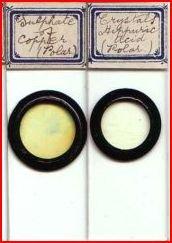
Suter chemical slides. Very probably one or other of the younger brothers, William or Harry Suter, was involved in making them, since both worked for chemists.
After Suter (the preparer’s) sister married, she continued to live at no.10 with her family. Perhaps there was a shed at the back, for modest equipment compared to that of bookbinding - alternatively of course, both slide preparation and the earlier bookbinding may have taken place elsewhere, in commercial premises. Unfortunately one cannot now examine details with such things as Google Earth, since Highweek Rd. no longer appears on maps and has vanished under redevelopment (possibly assisted along the way by the Luftwaffe).
Further biographical details on Suter
Richard Suter’s first days have a military background. His father, born in Portsmouth, at least from the age of 15 was working with his father Thomas Suter, both as bookbinders, at several inner London locations. Ann, the mounter’s mother, was variously given by census takers as born in Bangalore, or the “East Indies” (which included Malaysia and some Indonesian enclaves). He himself was described as born in Secunderabad, or the “East Indies”, or India. “East Indies” however usually just meant India as we now use the term. Richard senior is recorded in 1911 as on an army pension. Ann must have met him in India, while he was on army service – he disappears from the 1861 England census.
The Suter and Joseph families both moved sometime after 1881 from inner London to the then still partly rural Tottenham: hence they escaped east end claustrophobia, and possibly the fear of a further cholera outbreak. If anxiety over cholera was the stimulus, Richard senior had once already avoided that very real London danger by joining the colours in India, acquiring a wife in Bangalore or Secunderabad, and in due course a son (this being Richard Suter the future preparer, born in Secunderabad). By 1871 he was back in London, boarding with a James Hickinbottom in Shoreditch, at 11 Berenden St., with his wife Ann and Richard junior, and had again taken up bookbinding. He was still bookbinding in the same inner London street in 1881, but now with his own household at no.32, which by then included three daughters and another son. Young Richard (our future preparer) was training as a pupil/teacher, and continued teaching, as an assistant schoolmaster, on his subsequent arrival in Tottenham. He was there by October 1887 at the latest, as evidenced by his exchange column advertisement in Science Gossip. He may have joined a microscopical club, a quite likely action for a schoolteacher: if so, the Middlesex Natural History Society and Field Club, for instance, was not far off. Tottenham, by the time of Suter’s arrival there, was booming with housing development, but still contained much open land and some farms, ergo presumably considerable wildlife: there was at least one prolific collector of lepidoptera – F.H. Perry Coste – advertising exchanges in Science Gossip from Bruce Grove, Tottenham (Science Gossip, 1885, p.72). Another interesting Tottenham inhabitant, Mrs.Knight, was the widow of an Indian Army officer – Capt.Knight, who had been an enthusiastic diatomist: she may well have been known to Richard Suter senior, and may have possessed some of Capt. Knight's slides. A professional preparer, John Barnett, long established and with sales as far off as New Zealand, had much earlier made the move from inner London to Tottenham. Something made an assistant schoolmaster, with a fairly safe career before him, abandon this occupation in favour of full time entrepreneurial slide production. It is very possible that the example of Barnettt’s success, and local renown in Tottenham, inspired Richard Suter the young schoolmaster, and part time slide preparer, to make his career switch.
His new commercial enthusiasm soon extended to middle man activities for sales of microscopes and all manner of adjunct equipment. Many have noted his acquisition of Dancer's negatives, and failure to do anything with them. He was probably far too busy with other activities to get round to that until failing eyesight curtailed darkroom work. Finally – and this is speculative – an Edward D. Suter was elected to the Quekett Club in July 1879. This was the son of an architect (another Richard Suter!), born in Greenwich, who spent his whole professional life in inner London as a bookseller and commercial stationer, with several employees. The two families may have been related (and Isaac Joseph as a commercial stationer's clerk may also be relevant here). Our preparer's interest in microtechniques may date back to his London schooldays.
Envoi: more parallel examples
While the identity of Suter’s label designer must remain hypothetical in the absence of conclusive proof, it is hard to dismiss Isaac Joseph as by far the most likely candidate. The central aim of this article however is to identify the preparer of “other” slides, and on that score there is no question. More parallel examples shown below should remove any residual doubts.

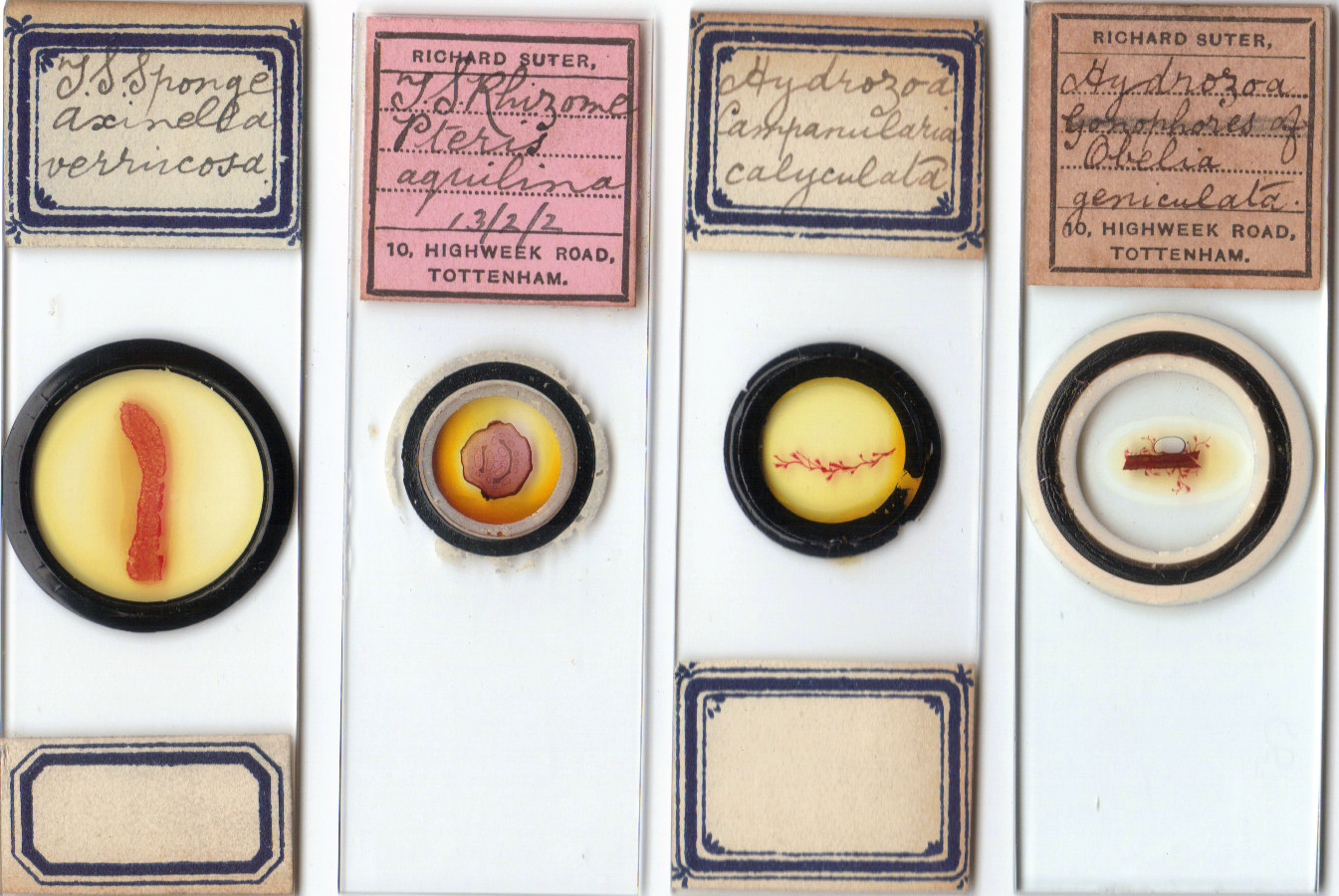
Comments to the author will be welcomed.
Acknowledgements
Thanks to Peter Hodds for locating “other” Suter slides, to David Walker for the approval slide example, and to Brian Stevenson for the Pharmaceutical Journal advertisement.
Sources
Ancestry.com
Hardwicke’s Science Gossip
Bracegirdle (1998) Microscopical Mounts and Mounters
1911census.co.uk
www.microscopist.net for Brian Stevenson's article on Capt.Knight.
Microscopy UK Front
Page
Micscape
Magazine
Article
Library
Published in the June 2010 edition of Micscape Magazine.
Please report any Web problems or offer general comments to the Micscape Editor .
Micscape is the on-line monthly magazine of the Microscopy UK website at Microscopy-UK .
© Onview.net Ltd, Microscopy-UK, and all contributors 1995 onwards. All rights reserved. Main site is at www.microscopy-uk.org.uk .